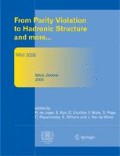Abstract
Measurements of the charge and magnetic form factors of the nucleon present a sensitive test of nucleon models and QCD-inspired theories. A precise knowledge of the neutron form factors at low Q 2 is also essential to reduce the systematic errors of parity-violation experiments. At the MIT-Bates Linear Accelerator Center, the nucleon form factors have been measured by means of scattering of polarized electrons from vector-polarized hydrogen and deuterium. The experiment used the longitudinally polarized stored electron beam of the MIT-Bates South Hall Ring along with an isotopically pure, highly vector-polarized internal atomic hydrogen and deuterium target provided by an atomic beam source. The measurements have been carried out with the symmetric Bates Large-Acceptance Spectrometer Toroid (BLAST) with enhanced neutron detection capability.
Access this chapter
Tax calculation will be finalised at checkout
Purchases are for personal use only
Preview
Unable to display preview. Download preview PDF.
References
J. Friedrich, T. Walcher, Eur. Phys. J. A 17, 607 (2003).
A. Faessler, Th. Gutsche, V.E. Lyubovitskij, K. Pumsaard, Phys. Rev. D 73, 114021 (2006).
D.S. Armstrong et al., Phys. Rev. Lett. 95, 092001 (2005).
T.W. Donnelly, A.S. Raskin, Ann. Phys. 169, 247 (1986).
D. Cheever et al., Nucl. Instrum. Methods A 556, 410 (2006); L.D. van Buuren et al., Nucl. Instrum. Methods A 474, 209 (2001).
C.B. Crawford, PhD Thesis, Massachusetts Institute of Technology (2005).
M. Jones et al., Phys. Rev. Lett. 84, 1398 (2000).
O. Gayou et al., Phys. Rev. Lett. 88, 092301 (2002).
V. Punjabi et al., Phys. Rev. C 71, 055202 (2005).
O. Gayou et al., Phys. Rev. C 64, 038202 (2001).
S. Dieterich et al., Phys. Lett. B 500, 47 (2001).
T. Pospischil et al., Eur. Phys. J. A 12, 125 (2001).
B. Milbrath et al., Phys. Rev. Lett. 80, 452 (1998); 82, 2221 (1999)(E).
G. Holzwarth, Z. Phys. A 356, 339 (1996).
E.L. Lomon, Phys. Rev. C 66, 045501 (2002).
H.-W. Hammer, Ulf-G. Meissner, Eur. Phys. J. A 20, 469 (2004).
F. Cardarelli, S. Simula, Phys. Rev. C 62, 065201 (2000); S. Simula, e-print nucl-th/0105024.
S. Rock et al., Phys. Rev. Lett. 49, 1139 (1982).
R.G. Arnold et al., Phys. Rev. Lett. 61, 806 (1988).
A. Lung et al., Phys. Rev. Lett. 70, 718 (1993).
K.M. Hanson et al., Phys. Rev. D 8, 753 (1973).
P. Markowitz et al., Phys. Rev. C 48, R5 (1993).
H. Anklin et al., Phys. Lett. B 336, 313 (1994).
E.E.W. Bruins et al., Phys. Rev. Lett. 75, 21 (1995).
G. Kubon et al., Phys. Lett. B 524, 26 (2002).
H. Anklin et al., Phys. Lett. B 428, 248 (1998).
H. Gao et al., Phys. Rev. C 50, R546 (1994).
W. Xu et al., Phys. Rev. Lett. 85, 2900 (2000).
W. Xu et al., Phys. Rev. C 67, R012201 (2003).
J.L. Friar et al., Phys. Rev. C 42, 2310 (1990).
G. Holzwarth, Z. Phys. A 356, 339 (1996).
G.A. Miller, Phys. Rev. C 66, 032201 (2002).
H. Arenhövel, W. Leidemann, E.L. Tomusiak, Eur. Phys. J. A 23, 147 (2005).
D.I. Glazier et al., Eur. Phys. J. A 24, 101 (2005) and references therein.
S. Galster et al., Nucl. Phys. B 32, 221 (1971).
V. Ziskin, PhD Thesis, Massachusetts Institute of Technology (2005).
E. Geis, PhD Thesis, Arizona State University (2007).
Author information
Authors and Affiliations
Consortia
Editor information
Editors and Affiliations
Rights and permissions
Copyright information
© 2007 Società Italiana di Fisica / Springer-Verlag
About this paper
Cite this paper
Alarcona, R., BLAST Collaboration. (2007). Nucleon form factors and the BLAST experiment. In: de Jager, K., et al. Proceedings of The 3rd Workshop From Parity Violation to Hadronic Structure and more.... Springer, Berlin, Heidelberg. https://doi.org/10.1007/978-3-540-74413-9_19
Download citation
DOI: https://doi.org/10.1007/978-3-540-74413-9_19
Publisher Name: Springer, Berlin, Heidelberg
Print ISBN: 978-3-540-74412-2
Online ISBN: 978-3-540-74413-9
eBook Packages: Physics and AstronomyPhysics and Astronomy (R0)

